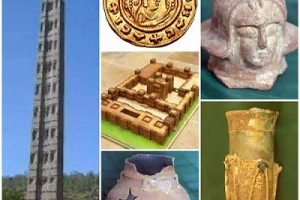The ongoing conflict in Sudan that is a culmination of political tensions simmering for several years, the devastating war that raged in Ethiopia during the past two years, and the continued instability in Somalia, the fragile and treacherous security situation in South Sudan, the constant threat of ethnic extremism and religious fundamentalism -these are some of the issues that made East Africa, particularly the IGAD region, one of the most troubled regions in the world, struggling with a series of violence and insurgency.
As if the internal tensions and divisions were not enough, the growing interest and uninvited interference of foreign powers in the sub-region has further complicated matters and made it difficult for states in the region to resolve their own problems effectively and independently.
The IGAD region is becoming increasingly militarized. World powers have recognized the strategic importance of the Horn in terms of trade routes and natural resources and are vying to gain the upper hand to secure a commanding presence and influence in the region through various ways including building military bases.
A recently published report indicates there is a massive presence of six foreign military bases in Djibouti, and more in Sudan, Eritrea, Somalia, and Somaliland. It says the Horn of Africa has become one of the most militarized and complex security regions, housing the largest number of foreign military bases in the world.
Apart from the man-made ones, natural disasters driven by climate change are causing multi-faceted challenges to the people in the Horn region in particular. According to a recent report released by the UN’s humanitarian aid agency, OCHA, for the past two years, the IGAD region has faced unprecedented challenges due to a persistent and prolonged drought, marked by five consecutive below average rainfall seasons.
And the drought led to severe water and pasture shortages, one million displaced people, over 10 million livestock and wildlife deaths, and reduced crop and livestock production, all of which are increasing food insecurity. Another UN agency, UNFPA last April announced that more than 43 million people need humanitarian assistance across Ethiopia, Kenya, and Somalia in 2023.
This year’s annual report of worldwide threats to the national security of the United States issued by the Office of US National Intelligence lists East Africa as one of the regions of the world whose volatile security situation is a national security threat to the United States and its allies. “In East Africa, prolonged internal conflicts are straining regional capacity and creating openings for increased involvement by external actors.” ,says the report.
The continual crisis of political instabilities and the accompanying violence and extremism [religious and ethnic], coupled with the recurring natural disasters has made million people of the Horn region food insecure and the largest recipient of food aid for several decades.
The good thing is scholars and political leaders of the sub-region have realized the key element to strategize the way out of the complicated maze of predicaments their people are facing. And that key factor is the responsibility of bolstering cooperation and integration among the states in the region to exert a more unified and concerted effort to address their common problems.
Cognizant of the need to create a united effort, the states in the Horn region established IGAD in 1996. They have also launched the Horn of Africa Initiative in 2019. These regional partnerships aim to bring lasting peace and political stability in the sub region by focusing on sustainable development activities, and thereby eradicating poverty, vulnerability to climate change, and boosting economic transformation and integration.
The regional body, IGAD says its central strategic role is to promote regional cooperation and integration among its eight member states to improve the welfare of all citizens. The focal area activities of IGAD‘s strategy are trade, industry and tourism, and infrastructure development. IGAD works toward harmonization of socio-economic policies of member states, cross border infrastructures as well as the development of a network of manufacturing and services industries that stretch across the region.
The Horn of Africa Initiative says it has identified priority trans-border development projects, which are assumed to change the lives of nearly 190 million people living in the sub-region for the better. The projects are financed by various international development partners like the World Bank, and African Development Bank. And most of them are infrastructure projects including roads and, energy sectors. They are at various statuses of implementation.
Practically, Promising progress in regional integration activities has been already accomplished in the IGAD region. Ethiopia’s GERD project which is now nearing complication is a mega project that interlinks neighboring economies like Kenya, Djibouti, and Sudan with power lines. In addition, Djibouti and Ethiopia have recently been reconnected with a modern railway system that transports both goods and passengers. Besides, feasibility has already been conducted to connect Addis Ababa, Khartoum, and Port -Sudan with a railway system stretching over 1500 km.
There is another multi-dimensional mega project aiming at integrating the economies of Ethiopia, Kenya, and South Sudan. The 25 billion dollar project, LAPSSET Corridor project, involves building interregional high ways linking a Kenyan port with the towns in Ethiopia and South Sudan. Moreover, the project consists of seven key infrastructure projects, including building a new port in Kenya, railways, oil pipelines, refineries, airports, and resort cities.
The Lappset Project, which is said to be the largest in Eastern Africa, would further strengthen the free movement and formal and informal trade in the region. This would expedite the socio-economic integration of the states in the region which pave the way for political integration.
Similarly, there are also other projects at various stages to interlink the countries of the IGAD region. The road projects linking Ethiopia with the Eritrean port city of Assab are cases in point. There was also a project proposal for the construction of gas/ oil pipelines stretching from Eastern Ethiopia to Djibouti.
Two of the IGAD member states, Kenya and Uganda teamed up with another eastern African state, Tanzania to form East African Community, EAC in 2000. Now EAC has grown fast comprising 7 East African states, and is confident of achieving political confederation within a few years. There is a real possibility that all IGAD member countries would be included in the EAC, which further would stretch from the shores Indian Ocean up to that the Red Sea. The integration of East Africa would be a stepping stone to African Unity and would make the sub-region strong enough not to be a pushover for foreign powers.
Regional integration is one of the taglines of the IGAD, and it has launched this week a public diplomacy campaign to promote regional integration by organizing a five-day Djibouti-Ethiopia railway caravan. That is quite commendable endeavor that would raise public awareness and participation in building peace and stability, expediting development through economic and political integration.
If the IGAD and EAC get enough support from a committed visionary leadership of member states to expedite the regional integration, in a decade or two, the troubled present of the region, the war, and the famine would only be history. And the young generation of the future would look history books to laugh at the crazy and senseless political situation of the present. They may ask these questions: why did Eritrea and Somalia go to war with Ethiopia? Why did Sudan divided into two different countries? What was the point of the two-year conflict in Ethiopia? Why did our fathers stayed all those decades separated, divided and entangled with internal conflicts and abject poverty? How short-sighted they must have been?
Solomon Wassihun
THE ETHIOPIAN HERALD THURSDAY 6 JULY 2023





